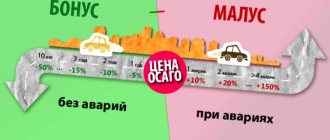The rules for using the KBM table will be useful both for professional drivers with many years of experience, and for car enthusiasts who have recently passed their exams and received their long-awaited license. The law, as they say, is the same for everyone!
For driving a vehicle without insurance (absent or expired), the fine in 2021 is 800 rubles and 500 rubles if the vehicle is driven by a driver who is not included in the insurance certificate. Tariffs for compulsory motor liability insurance are set officially by the State and a unified database is maintained for all insured persons.
What is KBM?
For drivers who did not get into an accident and drove the entire previous year without accidents, the value of the Bonus-Malus coefficient will decrease in the next calendar year, which means the cost of insurance under MTPL will be lower than last year. But the opposite is also true - a traffic accident was recorded with your participation and the insurance company paid the injured party for repairs, which means you will have to pay more.
For information:
From April 1, 2021, the calculation of the KBM for compulsory motor liability insurance has changed:
- The KBM value will no longer be lost if more than a year has passed since the last insurance;
- The date for changing the coefficient is the same for everyone - it is April 1 and the value is fixed and applied all year until the next April 1;
- The doubling of coefficients has stopped; if you have several cars, the KBM indicator has become the same for everyone;
- The minimum value of the BMR for the previous two years is taken into account if several different data are found in the database.
The maximum and minimum value, and what is the cost of insurance
If the driver gets into an accident, the MSC will increase, and during accident-free trips, on the contrary, it will decrease. Its value will be retained if the policy with the previous insurer is renewed or a transfer to another insurance company is made.
What kind of KBM is there? Its maximum value is set at 2.45 for class M, and the minimum is 0.5, which is set for the highest class 13. The more years a driver has driven without causing collisions with pedestrians or accidents, the higher his class will be and the lower the bonus-malus coefficient. Consequently, the price of a motor vehicle insurance contract will also decrease. If a car owner is at fault for an accident, he applies for insurance - the class is immediately lowered, and the coefficient increases. If the class becomes higher, then the cost of insurance decreases. Everything is extremely simple.
The KBM is calculated anew every year, taking into account its value at the time of concluding the MTPL agreement last year, as well as the number of insured events (cash payments) during the insurance period.
If the contract was in force during the year and there were no accidents, then the driver’s class increases by one unit, and the coefficient, accordingly, decreases by 0.05. Having reached class 13, the best indicator, within 10 years, the driver will receive a 50 percent discount on the policy. This will mean that for the entire ten years the insurance company did not have to pay compensation for accidents. If you cause road accidents more than 4 times in a year, then you can earn a maximum KBM of 2.45.
Table of values of KBM OSAGO from RSA for 2021
To make it easier to calculate the cost of insurance, there is a table with the main parameters that affect the price. This is the class at the beginning of each period, the value of the coefficient used when calculating the amount of insurance and the class of the next accrual period. Today there are 15 classes of driver insurance .
Let's consider in detail how to check or calculate the KBM using the Table as an example.
Instructions for use and table symbols
Initially, if you receive insurance under compulsory motor liability insurance for the first time:
- class at the beginning of the term.
The whole calculation starts from 3rd grade;
- KBM.
The coefficient is set to 1 .
It is from these two parameters that subsequent insurance discounts are calculated.
- End of term class.
After a year, the next class increases or decreases and this depends on your successful or not so successful driving during the year.
KBM table in 2021
In 2021, the following table is used to calculate the BMR:
| KBM coefficient for the KBM period | KBM coefficient | ||||
| 0 insurance claims during the KBM period | 1 insurance indemnity for the KBM period | 2 insurance claims during the KBM period | 3 insurance claims during the KBM period | More than 3 insurance claims during the KBM period | |
| 2,45 | 2,3 | 2,45 | 2,45 | 2,45 | 2,45 |
| 2,3 | 1,55 | 2,45 | 2,45 | 2,45 | 2,45 |
| 1,55 | 1,4 | 2,45 | 2,45 | 2,45 | 2,45 |
| 1,4 | 1 | 1,55 | 2,45 | 2,45 | 2,45 |
| 1 | 0,95 | 1,55 | 2,45 | 2,45 | 2,45 |
| 0,95 | 0,9 | 1,4 | 1,55 | 2,45 | 2,45 |
| 0,9 | 0,85 | 1 | 1,55 | 2,45 | 2,45 |
| 0,85 | 0,8 | 0,95 | 1,4 | 2,45 | 2,45 |
| 0,8 | 0,75 | 0,95 | 1,4 | 2,45 | 2,45 |
| 0,75 | 0,7 | 0,9 | 1,4 | 2,45 | 2,45 |
| 0,7 | 0,65 | 0,9 | 1,4 | 1,55 | 2,45 |
| 0,65 | 0,6 | 0,85 | 1 | 1,55 | 2,45 |
| 0,6 | 0,55 | 0,85 | 1 | 1,55 | 2,45 |
| 0,55 | 0,5 | 0,85 | 1 | 1,55 | 2,45 |
| 0,5 | 0,5 | 0,8 | 1 | 1,55 | 2,45 |
Examples of calculating KBM from the table
For accident-free driving during the year, the next year the cost of insurance is reduced by 5%, and the class moves to the next one. This happens annually until it reaches 50% (class 13) - less discounts are not established and this is a Bonus.
Expert opinion
Valery Volkov
Insurance expert
Buy eOSAGO through RSA
As can be seen from the table, if an accident was recorded (1 accident or more) with your participation and the company made a payment to the victim, then Malus comes into force, that is, an increase in the CBD rate and, naturally, an increase in the amount of annual insurance. Let's take a closer look at two examples.
No accidents or accidents
Let's assume that you drove the first year without an accident, come to your insurance company and your insurance policy will cost 5% less, i.e. a coefficient of 0.95 will be applied . The new class is already 4 . For the next year without accidents, there will still be a decrease of 5% (total 10%) and, accordingly, the BMR is equal to 0.90 . Class 4+1. And so on we look down at the columns and rows of the Table;
After an accident
We need to consider this option to know why the cost of insurance is increasing. Malus (M increase in KBM) depends on the number of recorded accidents per year, the more incidents, the longer the period in years when the price of your Policy will be the highest and unchanged. As can be seen from the Table, if during the first year of insurance you had 3 traffic accidents with your participation, the class is downgraded to M. The coefficient value increases to 2.45. And next year you will move to the very top of the Table, from where the next calculations will come.
How to calculate the KBM yourself
Calculating the BMR yourself is quite simple. You can use the table below and examples.
| Driver class | KBM | Number of payments under compulsory motor liability insurance by an insurance company during the year | ||||
| 0 payouts | 1 payment | 2 payments | 3 payments | 4 or more | ||
| M | 2,45 | 0 | M | M | M | M |
| 0 | 2,3 | 1 | M | M | M | M |
| 1 | 1,55 | 2 | M | M | M | M |
| 2 | 1,4 | 3 | 1 | M | M | M |
| 3 | 1 | 4 | 1 | M | M | M |
| 4 | 0,95 | 5 | 2 | 1 | M | M |
| 5 | 0,9 | 6 | 3 | 1 | M | M |
| 6 | 0,85 | 7 | 4 | 2 | M | M |
| 7 | 0,8 | 8 | 4 | 2 | M | M |
| 8 | 0,75 | 9 | 5 | 2 | M | M |
| 9 | 0,7 | 10 | 5 | 2 | 1 | M |
| 10 | 0,65 | 11 | 6 | 3 | 1 | M |
| 11 | 0,6 | 12 | 6 | 3 | 1 | M |
| 12 | 0,55 | 13 | 6 | 3 | 1 | M |
| 13 | 0,5 | 13 | 7 | 3 | 1 | M |
Let’s say the driver’s class at the time of concluding the new contract was M. Therefore, the KBM for him is 2.45. And the cost of insurance will increase exactly that much. If during the year the insurance company does not make a single payment for an accident, then at the beginning of the next insurance year the driver will move to class 1, and the cost of his OSAGO policy will be multiplied by a factor of 2.3.
Another, more telling example. Let's say the driver had class 12 at the beginning of the year. The discount on his policy will be 45%. And if during the year he does not cause any accidents, and the insurance company does not make payments, then his class will increase to 13. However, if during the year the insurance company makes at least one payment, then the class will drop to 6. And next year the discount will be insurance will be only 15%. Subsequent payments will also reduce the class down to M.
If the driver is a novice, then he is assigned class 3. The KBM in this case is equal to 1 and does not provide additional incentives or overpayments when purchasing an MTPL policy.
Restoration of KBM
To check the current value of the coefficient, drivers can use the Automated Information System (AIS) database on the website of the Russian Union of Auto Insurers (RUA) or a form on our website. The database is freely accessible and is intended only for Russian citizens and residents of the Russian Federation. If you do not agree with the data presented in the database, submit an application to the insurer to restore the KBM. It didn’t help, then file a complaint with the RCA. Just first check carefully whether all the parameters were specified correctly and that nothing was distorted in the request. Our auto lawyer is always ready to help you.
As you can see, from the above, the procedure for calculating and accounting for CBM values has now been established. You can quickly verify that the value is reflected correctly or make changes. The main thing is not to violate traffic rules and do not forget to take out insurance in a timely manner and thereby save your money on fines and an annual reduction in the amount of car insurance.
Why is KBM needed?
The bonus-malus coefficient is necessary in order to correctly calculate the cost of an MTPL insurance policy. By default, a driver purchasing MTPL insurance for the first time receives a BMR equal to 1.
Subsequently, the coefficient is calculated according to the table above:
- If a driver does not cause any traffic accidents during the year, then his BMR coefficient is reduced by 0.05.
- If, due to the driver’s fault, one or more accidents occurred, for which the insurance company made payments to other participants in the incident, then the driver’s BMI increases. Along with it, the cost of compulsory motor liability insurance for the next year also increases.
The final cost of MTPL depends not only on the CBM and you can find it out using the MTPL calculator.
OSAGO calculator
What is KBM and why is it needed?
KBM is a special bonus system, it is designed to encourage careful driving and also to protect insurers. With the help of the KBM system, insurance companies prevent large monetary losses, because in case of major accidents involving a novice driver, insurers must compensate losses to all victims, and this is unprofitable.
The bonus system works in such a way that newcomers initially have an inflated price for the policy; the more accident-free driving experience, the lower the price of car insurance. And vice versa, the more accidents in combination with short experience, the higher the price of the policy.
Table of values of KBM OSAGO
The main values in the table have been collected for the convenience of calculating compulsory motor liability insurance. It includes parameters of the vehicle class, the value of the BMC, as well as the class of the next calculation period.
You can check or calculate the performance of your own vehicle using the following table:
| Class | Your current KBM | Number of accidents caused by you | ||||
| 0 | 1 | 2 | 3 | > 4 | ||
| M | 2,45 | 2,3 | 2,45 | 2,45 | 2,45 | 2,45 |
| 0 | 2,3 | 1,55 | 2,45 | 2,45 | 2,45 | 2,45 |
| 1 | 1,55 | 1,4 | 2,45 | 2,45 | 2,45 | 2,45 |
| 2 | 1,4 | 1 | 1,55 | 2,45 | 2,45 | 2,45 |
| 3 | 1 | 0,95 | 1,55 | 2,45 | 2,45 | 2,45 |
| 4 | 0,95 | 0,9 | 1,4 | 1,55 | 2,45 | 2,45 |
| 5 | 0,9 | 0,85 | 1 | 1,55 | 2,45 | 2,45 |
| 6 | 0,85 | 0,8 | 0,95 | 1,4 | 2,45 | 2,45 |
| 7 | 0,8 | 0,75 | 0,95 | 1,4 | 2,45 | 2,45 |
| 8 | 0,75 | 0,7 | 0,9 | 1,4 | 2,45 | 2,45 |
| 9 | 0,7 | 0,65 | 0,9 | 1,4 | 1,55 | 2,45 |
| 10 | 0,65 | 0,6 | 0,85 | 1 | 1,55 | 2,45 |
| 11 | 0,6 | 0,55 | 0,85 | 1 | 1,55 | 2,45 |
| 12 | 0,55 | 0,5 | 0,85 | 1 | 1,55 | 2,45 |
| 13 | 0,5 | 0,5 | 0,8 | 1 | 1,55 | 2,45 |
Instructions for use and table symbols
There are basic rules for using the table presented above:
- in the first left column you can find the car class;
- the second shows the current coefficient indicator;
- the topmost line on the right combines 5 columns, which show the total amount of accidents that occurred due to the fault of the owner of the compulsory motor liability insurance;
- the cell at the intersection of the left column with the class and KBM designations and one of the top lines will be the current Bonus-Malus coefficient.
How to use the table to calculate KBM?
The table for KBM calculations includes information about the MTPL class, the value of the coefficient that corresponds to a certain class, as well as information on how the number of accidents during the annual insurance period affects the MTPL class.
| Class | KBM | Increase in price | Number of insured events (payments) that occurred during the period of validity of previous MTPL contracts | ||||
| – | 0 | 1 | 2 | 3 | 4 | ||
| Discount | Class to be assigned | ||||||
| M | 2,45 | 145% | 0 | M | M | M | M |
| 0 | 2,3 | 130% | 1 | M | M | M | M |
| 1 | 1,55 | 55% | 2 | M | M | M | M |
| 2 | 1,4 | 40% | 3 | 1 | M | M | M |
| 3 | 1 | No | 4 | 1 | M | M | M |
| 4 | 0,95 | 5% | 5 | 2 | 1 | M | M |
| 5 | 0,9 | 10% | 6 | 3 | 1 | M | M |
| 6 | 0,85 | 15% | 7 | 4 | 2 | M | M |
| 7 | 0,8 | 20% | 8 | 4 | 2 | M | M |
| 8 | 0,75 | 25% | 9 | 5 | 2 | M | M |
| 9 | 0,7 | 30% | 10 | 5 | 2 | 1 | M |
| 10 | 0,65 | 35% | 11 | 6 | 3 | 1 | M |
| 11 | 0,6 | 40% | 12 | 6 | 3 | 1 | M |
| 12 | 0,55 | 45% | 13 | 6 | 3 | 1 | M |
| 13 | 0,5 | 50% | 13 | 7 | 3 | 1 | M |
Using the KBM table is very simple. First you need to know the KBM. This information is available on the website of the Russian Union of Auto Insurers (RUA), you can contact the insurance company or look at the KBM in the current policy (some companies indicate the class directly in the insurance). All other sources are considered unreliable.
If a citizen enters into a MTPL agreement for the first time, he is assigned class 3, for which the BMR is 1.00. Therefore, no discounts or surcharges apply.











